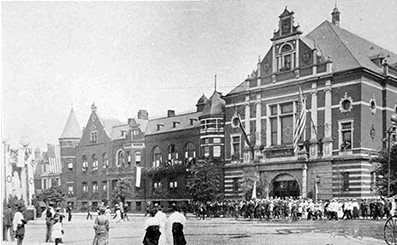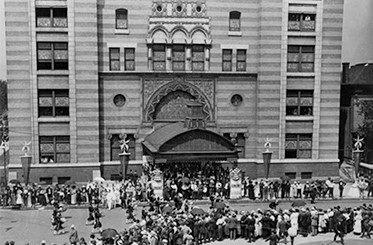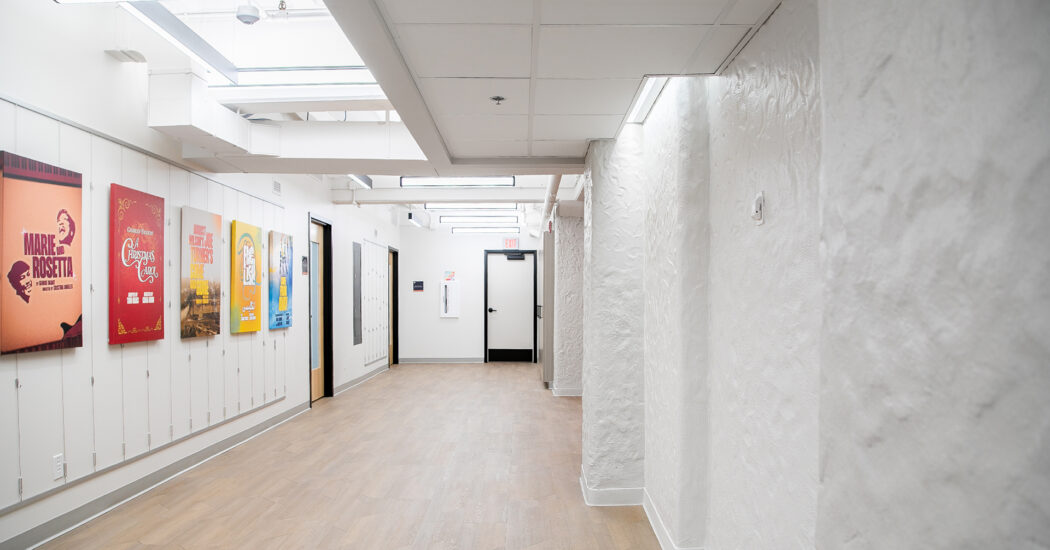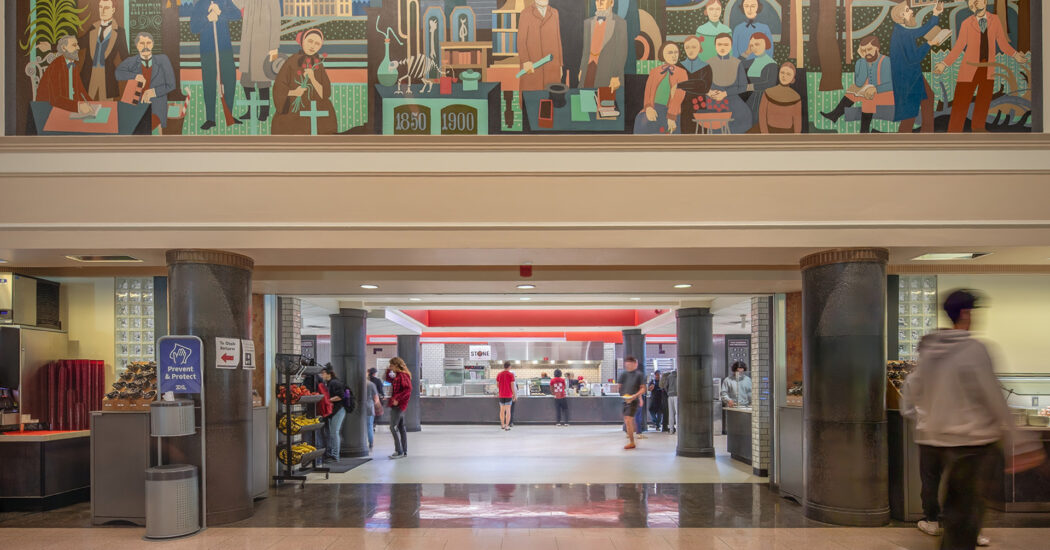Mass Ave Isn’t What It Used to Be: Urban Revitalization in Indianapolis
-
Category
Studio-Community, Innovation -
Posted By
Steve Alspaugh -
Posted On
Jul 17, 2019
Years of redevelopment and steadfast anchor institutions are to thank for the Mass Ave we know and love.
Did you know that MacNiven’s used to be a biker bar? Maybe you noticed the original “Sears, Roebuck and Company” still etched into the west side of Needler’s Fresh Market at the corner of Alabama and Vermont Streets. Even the buildings that make up the Schmidt Associates’ office have been everything from a paint and wallpaper store to a coffee shop and restaurant.
Massachusetts Avenue—affectionately called Mass Ave or the Avenue by most—has been in constant transformation. New restaurants seem to pop up daily, and recent (and ongoing) new construction is making more room for apartments, offices and entertainment options.
This intimate downtown stretch didn’t always look the way it does now. In fact, it was once considered somewhat of a “red light district,” a seedy stretch you wouldn’t want to take selfies in front of.
Over the past four decades or so, the landscape of this downtown thoroughfare has changed dramatically, making it a prime example of urban revitalization. After years of redevelopment, the Mass Ave neighborhood eventually became the cultural hub that it is today.
A Brief History of Mass Ave
The footprint of Indianapolis was designed by Alexander Ralston (yes, Ralston’s DraftHouse is named after him), who also laid out the streets of Washington, D.C.
Like D.C., Indianapolis has several diagonal roads that sprout out from Monument Circle. Mass Ave is one of them, making it—at one time—a major artery connecting the commercial downtown and residential outskirts of the city.

Mass Ave circa 1906 (Photo Courtesy of the Indiana Historical Society)
Between about 1940 and 1960, a mass migration from cities to suburbs occurred across the U.S. Approximately 40 million people abandoned the hustle and bustle of downtowns in favor of quiet suburban streets. These suburbs started to become self-contained, with their own shops, schools, and police departments. Indianapolis was no exception.
The construction of the interstate, which cut directly through Mass Ave, in the 1970s fueled this exodus of city dwellers, giving them an easy way to travel back downtown when necessary.
By the late 1970s, when Schmidt Associates moved into the Hammond Block at 301 Massachusetts Ave., the view down the Avenue was bleak. There were many boarded up buildings, and the open businesses were far from the trendy boutiques and restaurants we see now.

Mass Ave Circa 1970s
With our offices perched at the starting point of the street, our firm had a unique position and ability to take part in the revitalization of Mass Ave. We’ve made our humble mark along the Avenue over the years—from our work on the Stout’s Shoes building in the 1980s, to our office’s move to our current home at 415 Massachusetts Ave. (right image above), to the completion of the new Penrose on Mass building in 2018. And both our leadership and staff have been committed to this revitalization through active participation with local non-profits and community engagement.
No single person or organization could have made this significant transformation. A powerful combination of support from community and economic development organizations, private businesses, and federal tax credits for revitalization of historic buildings helped bring new life to Mass Ave.
However, none of these efforts would have been sustainable without another important player: the anchor institution.
Anchor Institutions Leading the Charge
An anchor institution is a place that holds influence in a city or other geographic area. It quite literally “anchors” the area by helping to provide a point of stability that attracts residents and other businesses.
Often, we think of a university, the headquarters of a major corporation, a professional sports stadium, or a hospital as an anchor institution in a city. These companies give meaning to an area, providing jobs and spurring new housing developments, commercial business, and more. Each neighborhood within a city can have its own, smaller anchors, as well.
Mass Ave would not be the place it is today without the anchor institutions that established it as a destination neighborhood in Indianapolis. Here are a few we have to thank:
The Athenaeum

Athenaeum Circa 1910 (Photo Courtesy of the Athenaeum Foundation)
The Athenaeum was designed by Bernard Vonnegut (Kurt Vonnegut’s grandfather) and was built in phases between 1893 and 1898. It was envisioned as a “house of culture for the mind and body,” according to the Athenaeum Foundation. True to that purpose, it has played host to countless theater productions, public speeches, and other community gatherings and celebrations.
The building was also once home to the Normal College of the North American Gymnastic Union and held gymnastics trainings. This made it a perfect fit for the YMCA, which moved in in 1992. And of course, the Rathskeller, Indianapolis’ oldest restaurant still in operation, opened in the Athenaeum’s basement in 1894.
Today, the Athenaeum building remains a cultural focal point. It has a coffee shop with a large working/meeting space, the Rathskeller beer garden and outdoor concert venue, and various office and performance spaces for art and education organizations.
Circle City Industrial Complex

Schwitzer Cummins Co., Circa 1930s (Photo Courtesy of Circle City Industrial Complex)
Built in the early 1920s, the building that is now the Circle City Industrial Complex (CCIC) provides an anchor further northeast on Mass Ave. It was originally home to the Schwitzer Cummins Corporation automotive plant. The plant was part of the booming auto industry in Indianapolis and across the country.
While the interstate now divides Mass Ave just before you get to CCIC, the campus remains an anchor in the area, known as the Mass Ave Industrial Corridor. CCIC is currently being redeveloped, in large part due to efforts of the Riley Area Redevelopment Corporation, which is also responsible for much of the public art along Mass Ave, as well as affordable housing and other economic development efforts. The former factory building is now home to a variety of artisans and makers, non-profits, and other businesses.
The Murat

Murat Theatre Circa 1900s (Photo Courtesy of the Murat Shriners)
Now named Old National Centre, the Murat Theatre was completed in 1910 by a group called the Murat Shriners. The Shriners were members of a secret society called the Ancient Arabic Order of the Nobles of the Mystic Shrine. The temple served as a ceremony and meeting place for decades and is still under ownership of the Shriners.
In 1995, Live Nation became a tenant of the theater, bringing big-name live shows and concerts to Mass Ave. This was, and continues to be, a significant driver in attracting new restaurants and bars to satisfy eventgoers before and after shows.
The Future on Mass Ave
It has taken decades for development on Mass Ave to elevate to its current state. Every decade since the late 1970s has brought about its own hallmark projects along the Avenue.
Today, Mass Ave has something of significance on almost every block. And there’s more to come, like the in-progress Bottleworks building, which is an adaptive reuse of the historic Coca-Cola Bottling Plant. The project includes the Avenue’s first hotel, plus unique retail and gathering spaces, which will bring more activity to the northeast end of the street.
While most large parcels of land are now occupied, there are some gaps to fill in and opportunities to build north and south of the strip. As development continues, it’s important that we remember to preserve the organic and intimate character of Mass Ave.
When you walk down the street, you see pockets of new construction, but you mostly see a lot of old buildings—a blend of architectural styles from over the years, most no more than five or six stories tall. Those strong, old bones are still here, but they’ve been given new life and purpose. That is what revitalization is all about.







